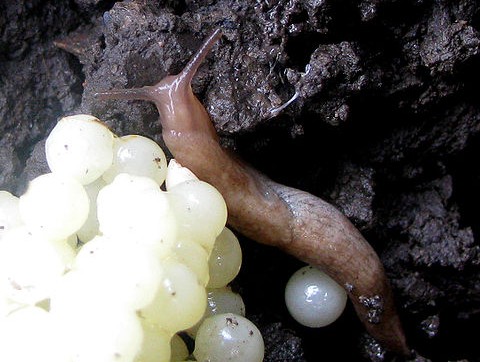
 Description: Slugs are closely related to snails and both are mollusks. Slugs can be thought of as a snail without a shell. They have a muscular foot that extends the length of the body, a saddle-shaped mantle to protect their heads, and two sets of tentacles. The longer pair of tentacles terminates in eye spots that detect light and dark, the shorter pair has scent receptors. Both sets of tentacles are retractable and can regenerate if lost. Slugs shred their food by means of a radula, a tongue like organ covered with thousands of tiny teeth. The body of a slug is made up primarily of water and is prone to drying out. Copious amounts of mucus are produced by the slug that aid in maintaining body moisture but also help in movement. The slime trail left by slugs helps it find a mate. Slugs are hermaphrodites so can both give and receive sperm during mating. They mate when only a few months of age and can lay hundreds of eggs every year. The eggs are tough, elastic, and prone to dry out but can be seen in damp soil.
Description: Slugs are closely related to snails and both are mollusks. Slugs can be thought of as a snail without a shell. They have a muscular foot that extends the length of the body, a saddle-shaped mantle to protect their heads, and two sets of tentacles. The longer pair of tentacles terminates in eye spots that detect light and dark, the shorter pair has scent receptors. Both sets of tentacles are retractable and can regenerate if lost. Slugs shred their food by means of a radula, a tongue like organ covered with thousands of tiny teeth. The body of a slug is made up primarily of water and is prone to drying out. Copious amounts of mucus are produced by the slug that aid in maintaining body moisture but also help in movement. The slime trail left by slugs helps it find a mate. Slugs are hermaphrodites so can both give and receive sperm during mating. They mate when only a few months of age and can lay hundreds of eggs every year. The eggs are tough, elastic, and prone to dry out but can be seen in damp soil.
 Control: There are several steps you can take to reduce the slug population in your garden. Some are more difficult or time consuming to execute but all will help the problem.
Control: There are several steps you can take to reduce the slug population in your garden. Some are more difficult or time consuming to execute but all will help the problem.
-
1. Eliminate garden debris like decaying vegetation and any items likes boards or cinder blocks that might provide a cool humid environment for the slug to use during hot dry times.
2. Hand pick slugs in the evening when the slugs come out to eat and drown them in a can of soapy water. Alternatively, spray the slugs with a 50% solution of white vinegar and water to kill them.
3. Make rings around the plants you wish to protect with a substance that will irritate the slug’s underside as it moves and lead to dehydration. This includes diatomaceous earth, ground egg shells, wood ashles, and coarse hair (human, horse). The diatomaceous earth is my favorite as it is cheap, readily available, easy to use and effective. All of these substances, however, are most effective in dry weather as moisture makes them less irritating and the slug better able to survive dehydration.
4. Traps can be made of inverted flower pots on 1” block, tuna fish cans filled with beer, the rinds of melons or citrus fruits. The traps should be checked daily.
5. Place strips of copper wire or pieces of copper screen around the plants. The copper gives the slug an electric shock.
6. Interplant the plants attractive to slugs with plants that repel them. Rosemary and wormwood (Artemisia absinthium) are the best.
7. Grow plants that are not attractive to slugs such as lavender, sage, begonia, geranium, and impatients.
Depending on your climate and the habitat you offer your slug population, some measures will work better than others. Experiment with various methods to find the one that works best for you. Vigilance is the key to success; as soon as you see a silivery mucus trail or irregular holes in the leaves of plants start your efforts to rid your garden of these slimy pests.
To buy diatomaceous earth from Amazon.com click here.
Photo from Wikimedia Commons